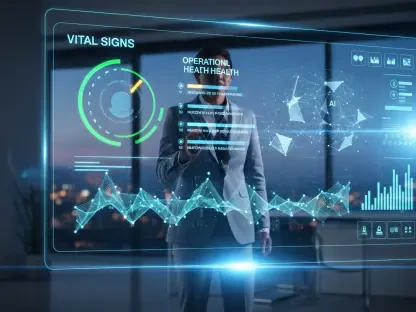Diving into the Future of Dining Transactions
In an era where convenience reigns supreme, the hospitality industry stands at a pivotal crossroads with over 156,000 restaurant locations globally already leveraging digital tools for efficiency, and Boston-based Toast, a titan in restaurant software and payments, is poised to redefine the dining experience with its exploration of checkout-free “eat-and-run” technology. This market analysis examines the potential of Toast’s innovative payment system to disrupt traditional checkout processes, delving into current trends, financial data, and competitive dynamics within the hospitality tech sector. The purpose is to uncover how this emerging technology could shape market share, customer expectations, and operational strategies for restaurants worldwide, while providing actionable insights for stakeholders navigating this transformative landscape.
Unpacking Market Trends and Projections in Hospitality Tech
The Rise of Frictionless Payments in Dining
The hospitality sector is witnessing a seismic shift toward frictionless transactions, driven by consumer demand for speed and simplicity. Toast’s proposed eat-and-run system, which allows diners to exit without waiting for a bill by using pre-stored payment card information, aligns with a broader trend seen in retail environments like Amazon’s checkout-free stores. Industry data indicates that seamless payment solutions can boost customer satisfaction by up to 20%, a significant factor in an industry where repeat business is critical. As restaurants grapple with labor shortages and rising operational costs, adopting such technology could streamline post-meal processes, potentially reducing wait times by half in high-traffic venues.
This trend is not without precedent, as competitors and adjacent industries have tested similar models with mixed outcomes. For instance, checkout-free systems in sports stadiums and airport shops have shown promise in cutting transaction times, yet adoption remains limited due to integration challenges. Toast’s focus on integrating this tech with existing reservation and waitlist tools positions it uniquely to overcome these hurdles, targeting a niche yet vast market of dine-in establishments hungry for innovation. Market projections suggest that by 2027, over 30% of mid-to-large restaurant chains could adopt some form of frictionless payment, with early movers like Toast potentially capturing a significant share.
Financial Momentum and Market Positioning
Toast’s financial performance provides a robust foundation for its ambitious tech ventures, reflecting its capacity to invest in cutting-edge solutions. In the third quarter of this year, the company reported a net income of $105 million, a sharp rise from the previous year’s figures, alongside a 25% revenue increase to $1.63 billion. Its annualized recurring run rate (ARR) surpassed $2 billion, marking a 30% growth, while the addition of 7,500 new client locations brought its total to 156,000. These metrics underscore Toast’s ability to scale innovations like eat-and-run tech, supported by strategic partnerships with major brands such as TGI Friday’s and Nordstrom’s dining outlets.
In a competitive landscape dominated by players like Square, Clover, and Lightspeed Commerce, Toast’s integrated platform offers a potential edge. Unlike rivals who primarily focus on point-of-sale systems, Toast’s ecosystem spans payments, reservations, and operational tools, creating a seamless entry point for checkout-free solutions. Analysts anticipate that if Toast achieves its goal of reaching $10 billion in ARR by 2035, it could double its current market share, reshaping competitive dynamics. However, high development costs and the need for widespread restaurant adoption pose risks that could temper this growth trajectory if not managed strategically.
Regional Dynamics and Adoption Challenges
Geographic and cultural nuances play a critical role in the potential rollout of Toast’s frictionless dining tech. Urban markets, characterized by fast-paced lifestyles, are likely to embrace quick-exit payment systems, with cities like New York and Los Angeles serving as ideal testing grounds. Conversely, smaller towns or regions with a strong tradition of personalized service may resist, valuing the human interaction tied to traditional checkouts. Data privacy regulations, particularly in Europe under GDPR, add another layer of complexity, potentially slowing global expansion unless tailored compliance strategies are implemented.
The diversity of restaurant types also influences adoption rates, as large chains may integrate such tech more readily than independent eateries due to budget constraints. Industry insights suggest that partnering with established chains could accelerate market penetration, creating a ripple effect among smaller players. A key challenge lies in dispelling the myth that checkout-free systems diminish staff roles; instead, they could free up servers to focus on hospitality, a benefit Toast must emphasize to gain trust. Overcoming these regional and sectoral barriers will be crucial for the technology to achieve widespread acceptance by 2027.
Emerging Innovations and Economic Drivers
Beyond frictionless payments, the hospitality tech market is evolving with innovations like AI-driven menu personalization and contactless ordering, reflecting a broader push for digital transformation. Economic pressures, including rising labor costs projected to increase by 5% annually through 2025, are compelling restaurants to automate processes, making Toast’s eat-and-run concept timely. Technological advancements in biometrics and secure payment verification could further enhance the reliability of checkout-free systems, addressing concerns over billing accuracy and fraud.
Market forecasts indicate that within a decade, seamless dining experiences could become standard, with integrated platforms like Toast’s leading the charge. Regulatory shifts around data security will shape the pace of adoption, requiring companies to balance innovation with compliance. For Toast, aligning with these trends while maintaining a customer-centric focus could solidify its position as a market leader, especially if it leverages its current ARR growth to fund research and development. The intersection of economic necessity and technological possibility paints a promising yet complex picture for the future of dining transactions.
Reflecting on Market Insights and Strategic Pathways
Looking back, this analysis highlighted how Toast’s exploration of eat-and-run technology captured a defining moment in the hospitality sector’s digital evolution. The robust financial growth, with revenue climbing to $1.63 billion and ARR hitting $2 billion, underscored the company’s capacity to drive innovation amid fierce competition from Square and Clover. Regional adoption challenges and emerging trends like AI integration revealed both opportunities and obstacles that shaped the market landscape.
For stakeholders, the next steps involve strategic experimentation, such as piloting checkout-free systems in urban hubs to gather real-world data on customer response and operational impact. Restaurants are encouraged to assess long-term cost-benefit ratios of adopting such tech, while Toast needs to prioritize transparency in data handling to build diner trust. As the industry moves forward, fostering collaborations with regulatory bodies to navigate privacy concerns emerges as a critical consideration, ensuring that the promise of frictionless dining translates into sustainable market growth.









